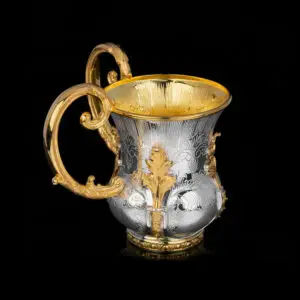
Deciphering the Elegance: How to Grade and Evaluate Silverware
In the world of luxury goods, the art of grading and evaluating is often associated with diamonds and coins, where established grading systems like those by De Beers and PCGS or NGC reign supreme. However, when it comes to silverware, grading the quality of items such as candlesticks, trays, or Judaica pieces is less common yet equally significant. Recognizing this gap, Hazorfim Ltd, a global leader in silverware and Judaica since 1952, has embraced the challenge of creating an international grading and evaluating system tailored specifically for silverware. Let’s delve into the intricacies of this system, built upon four key criteria:
- Originality of Design:
At the heart of grading silverware lies the originality of design. This

criterion assesses the uniqueness and creativity of the design, distinguishing exceptional pieces from the mundane. A truly remarkable silver item captivates with its innovative motifs, intricate patterns, and artistic flair. Whether it’s classic candlestick or an ornate Judaica masterpice, originality of design sets the stage for exceptional craftsmanship and aesthetic allure.
- Silversmith’s Expertise:
The hallmark of superior silverware lies in the mastery of the goldsmith. This criterion evaluates the silversmith’s expertise based on

several factors, including proportion, detailing, and the quality of silversmith workmanship. From precise hammering techniques to seamless brazing and meticulous attention to detail, the craftsmanship of the goldsmith is evident in every facet of the silver item. It is this unparalleled skill and dedication that elevates silverware to a level of unmatched sophistication and elegance.
- Silver Thickness:
A tangible indicator of quality, the thickness of silver plays a crucial role in grading silverware. Thicker silver not only imparts a sense of weightiness and opulence to the item but also enhances its durability and longevity. Moreover, a thicker silver product commands a higher price, reflecting the superior craftsmanship and material quality involved in its production. However, it’s important to note that achieving the desired thickness poses a significant challenge for silversmiths, requiring precision and expertise to execute flawlessly.
- Level of Finishing:
The final criterion in evaluating silverware is the level of finishing, encompassing the refinement and polish applied to the piece. A

flawless finish enhances the visual appeal of the silver item, accentuating its beauty and sophistication. From mirror-like surfaces to satin-smooth textures, the level of finishing reflects the meticulous attention to detail and commitment to excellence exemplified by Hazorfim Ltd and other renowned silverware manufacturers.
In conclusion, grading and evaluating silverware is a nuanced and multifaceted process that requires an appreciation for craftsmanship, design, and material quality. Hazorfim Ltd‘s pioneering efforts in establishing an international grading system underscore the significance of recognizing excellence in the realm of silverware. By adhering to rigorous criteria such as originality of design, goldsmith’s expertise, silver thickness, and level of finishing, aficionados and collectors alike can discern the true value and elegance of silverware, elevating it to the realm of timeless artistry and refinement.
Below you can find a sample of Hazorfim Ltd.’s official certificate under:
“International Silverware Institute by Hazorfim

Annex: Commonly Used Silver Alloys in Silverware
Understanding the types of silver alloys used in the creation of silverware is crucial for both crafting and grading these exquisite items. Each alloy has unique properties that influence the final product’s aesthetic, durability, and workability. Below, we delve into the three most prevalent silver alloys:
Fine Silver (Marked 999)
- Composition: 99.9% silver
- Usage: Predominantly used in the manufacture of coins and articles created using electroforming technology.
- Properties: Fine silver is highly valued for its purity, luster, and color. Being the closest to pure silver, it is relatively soft and malleable, making it less suitable for items that require high durability but ideal for high-detail decorative pieces.
Sterling Silver (Marked 925)
- Composition: 92.5% silver and 7.5% copper
- Usage: This is the most common alloy used in silverware due to its excellent balance of durability and workability.
- Properties: Sterling silver is highly favored for its excellent mechanical properties, including increased hardness and durability, which make it ideal for everyday use in items such as cutlery, trays, and decorative objects. The addition of copper improves its strength and resilience without compromising the beautiful sheen of the silver.
Silver 800 (Marked 800)
- Composition: 80% silver and 20% copper
- Usage: Frequently used in larger casted items such as big trays, decorative bowls, and other substantial pieces.
- Properties: This alloy provides even greater durability and hardness than sterling silver, making it suitable for larger items that require more structural integrity. The higher copper content ensures that the items are robust, though it slightly reduces the luster compared to finer silver alloys.
These alloys not only determine the utility and beauty of the silverware but also influence their grading and valuation. Recognizing the type of silver used is essential for accurately assessing the quality and value of silver items, catering to collectors and professionals who seek to understand the nuances of their collections.

President Trump 1 Oz Silver Round
Donald Trump: 45th President, Now Available in Beautiful .999 Pure Silver Donald Trump will go down as one of the most iconic presidents in American

2024 Gold American Eagle Coin – 1 Troy Ounce, 22k Purity
. 2024 Gold American Eagle Coin – 1 Troy Ounce, 22k Purity Highly popular American Eagle gold coin series in the 1 oz gold bullion size,

Exploring the World of Silver: Coins, Proof Coins, and Rounds
Exploring the World of Silver: Coins, Proof Coins, and Rounds Silver, a lustrous, white metal, has captivated humanity for thousands of years. Its use in
